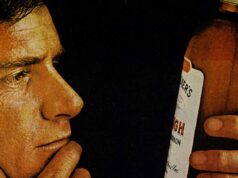In the fall of 2001 outraged Cleveland Browns fans hurled beer bottles at NFL referees, and everyone was outraged.
Tales came to light of Babe Ruth’s penchant for rampant boozing, before, during, and after hitting the bases, and everyone was outraged. Dozens of universities across the country have banned the sale of alcohol at sporting events, and the students were outraged. Some professional sports venues are considering a two-drink maximum, accomplished by the stamping of hands — two and you’re done — and season ticket holders are outraged.
Yuppified and rigidly safe factions of our country, bafflingly still referred to as the “home of the free,” has aimed their shrill moralism at the booze/sports partnership. As is usual with shrill moralists, those seeking to rid sports of Dangerous and Lewd Boozing are misinformed, ignorant of history, and interested primarily in enforcing their will on a group that vastly outnumbers them. Mostly, though, they are ignorant of history.
Try this on: booze made sports.
Without the first, we might never have had the second. It might appear, at first glance or from first-hand experience, that spectator sports got there first, and only later did folks realize that a tasty libation really made the thing exciting. After all, how many pints have you polished off while doing the wave, craning up at the Jumbotron, or belligerently coaching your favorite team from the comfort of a Lay-Z-Boy? Surely liquor came to the party second. How could it be otherwise?
Sometimes, and this is one of the big reasons we annoy other species so much, we think that we (our group, our circle, etc.) are operating on a level of sophistication unknown to previous generations. It comforts us to pat our psyches on the back, congratulations for being … well … just so with it. We tip our drinks, shout “rah rah shish boom bah,” and bask in the glow of our warm and inviting State of Progress. Quite frankly, we think the vast majority of those who came before us were dimwits. It simply cannot be that long ago the first sports fan got sozzled in the stands.
Roughly speaking, it was about 3,000 years ago, probably even more.
And the booze got there first. Spectator sports arrived late — then lost their keys, spilled the bean dip, barfed in the fish tank, and sang “We Will Rock You” every time something happy took place.
As everyone knows, the Olympics were first held in ancient Greece — running, wrestling, throwing things, and the whole scene, except instead of medals the victors got ivy wreaths put on their heads. (They also missed out on Nike ads, but that’s another story.)
For the most part, Olympic sports are all about individuals. Disregarding things like volleyball for the moment, it’s safe to say that Olympic athletes compete primarily against themselves. Putting groups of athletes together in groups, with group aims and group cooperation, was a somewhat later invention. Team sports are also almost completely dependent upon balls. No, not cajones, but real balls. Toys, ultimately. Play things. The big team sports we have with us today — baseball, football, soccer, basketball, etc. — all share a single-minded concern with getting your hands on a ball, and then, through skill and luck, putting the ball someplace where the other group doesn’t want it to be. There are lots of other rules, of course, but in their essence team sports — most popular among spectators — are quite beautiful in their simplicity.
But enough about sports. Let’s talk ancient alcohol rituals for a moment.
The world was (and still is) chock-full o’ drinking rituals. On every continent, among most cultures, people used intoxication to fuel their spiritual tanks, and as a muse for the creation of about anything you can name. And nowhere was the connection between drink and society as intrinsic as in ancient times.
Attic Greeks drank mead (ambrosia, the fabled Nectar of the Gods) and beer (brewed with techniques learned from the Egyptians), but the drink of choice, the T-Rex of ancient tippling, was wine.
Pretty much every aspect of Greek viticulture — from planting, to harvesting the grapes and pressing them, to storage and aging — was accompanied by splendid rituals. At harvest time, for example, the grape pickers sang a song for the fruit. It was a hymn-like ode to loss and rebirth — they mourned the killing of the grapes, but also celebrated next year’s abundance. While they sang a young boy carried a large wooden phallus among the vines, a symbol of the god of wine, Dionysos, whom the boy represented. Grape picking was considered something of an honor among Athenians. Equal care was taken with the remainder of the winemaking process; giving thanks, singing songs, honoring Dionysos in voice and action, until it was time to drink.
Long about the time of year we call November, Athens exploded in an uproarious, joyous, naughty celebration — the Great Dionysia, or Festival of Dionysos. It was during the Dionysia that the first of last year’s wine, having been aged underground in large clay vessels called amphorae, was finally brought out, sampled, and revered. The streets literally ran with wine for three full days and nights. The Great Dionysia made Mardi Gras look like Bingo Night at the Lawrence, Kansas VFW.
Before anyone got to taste the wine, priests of Dionysos performed the most important ritual of all — arguably the most important ceremony they performed all year. A bull, that had been specially nurtured all year, groomed, fattened, made as aesthetically appealing as possible (for Dionysos was also called the Bull God), was brought to a special altar, usually in the orchestra (“dancing place”) of a theater; a place sacred to Dionysos. After songs and prayers, the bull was cut down with a broad-headed ax, then dismembered.
The dismemberment was a reenactment of the most well known myth of Dionysos, wherein the young god — born from one of Zeus’s many dalliances with mortal women, this time a stunning young thing named Semele — was hunted down by agents of Zeus’s wife, Hera, and torn to pieces as revenge against her philandering hubby. Later, Zeus ordered the Nymphs to take the pieces to a sacred cave, and the Dionysos was reborn with the coming of spring. This is how he came by another of his appellations, the Twice-Born God.
The Athenians, not at all a wasteful culture, made use of the entire sacrificed bull. Its fat was trimmed away from the meat, then the meat from its bones, which were then wrapped in strips of its fat and roasted over a roaring fire. The cooked fat and bones were dedicated to all of the Olympian deities, a thank-you barbecue to appease the surliest pantheon this side of John Ashcroft’s misimagined Christian thunderer. The bull’s meat was boiled, seasoned, then passed out to the citizens. Its hooves and horns were carved into dice and jewelry.
And then there was its hide — the best part, the bee’s knees, the cat’s pajamas, the ne plus ultra of its ruminant soul, the Giradelli of mammal casings, a Coltrane solo of fresh leather.
Before the bull’s carcass was dismembered, it was carefully skinned, then stretched and scraped, and dried in the sun. When dry, it was sewn back together, retaining (roughly) its bovine shape. An opening was left at the neck, and the whole thing was filled with wine and stitched up tight around a spout. From this enormous bull-balloon splashed the first magical streams of wine. The people lined up for their communion with the god of the grape. They drank the skin dry, refilled it, drank it dry again. This went on for some time, until the celebrants were sufficiently sloshed, and the Dionysia broke free of its ritualized constraints and flooded into the city, filling it with song, dance, and freewheeling sex.
Not one bit of this sounds like it has anything to do with sports, does it? Wasn’t this document, before it turned into a verbose history lesson, supposed to be about how sports were spawned by intoxicating beverages?
Fine. Here you go.
Once the Dionysia was chugging ahead under its own besotted power, the bull’s skin was filled one last time with wine, but this time the spout was tossed and the hole sewn shut. The bloated, sloshing, bull-shaped sack was rolled to the center of a field and slathered with olive oil to make it slippery. Celebrants gathered around it, and commenced a game, sort of like keep-away crossed with king of the hill. The sack was crawled on, rolled around, held aloft, and tossed about. After a proscribed span of time passed, the person in sole possession of the hide was declared the winner. It is unknown what, if any, prize the winner received.
Here’s a thought experiment. Give it a go.
Imagine the natural tendency we humans have to form groups. Imagine our innate ability to cooperate (when the mood suits us). Imagine centuries of the bull-sack game, and how the passing of time would surely affect its dynamics. Imagine how when something is repeated often enough is begins to adopt its own structure.
Imagine soccer.
Better yet, imagine football, or rugby.
Shrink the wine sack. Form a group. Corral the chaos with a handful of simple rules. Invite your friends to watch. When they see something exciting they might cheer. Imagine the moment when you become so adept at this ancient ritual, this loving, joyous, burst of tipsy spirituality, that you become known for your abilities. You become a specialist. Then some more people do, and the ritual/game is now so fun to watch you attract a crowd that wants nothing more than to bear witness while your strut your stuff.
This weekend, when you and your friends gather in front of the TV to watch one group of people keep a small wine skin away from another group of people, and you pop the top on a beer, or knock back a tequila shot when the home team does something incredible, watch that wine skin (we’ll call it a “ball”, one letter shy of “bull”) and remember.
Our sports aren’t sacred. They aren’t acts of communion with Mystery.
What they are, when they elevate us and make us cheer, is a reminder of how we look nothing like, and exactly like, those who have come before. Trying to rid sports of alcohol is silly and pointless. You can’t have one without the other (or maybe you can, which would explain synchronized swimming, but that’s another story).
Spectator sports are, at their most primal, an echo, reverberating out of the past, of a time when alcohol meant something more than happy hour.
—Richard English










